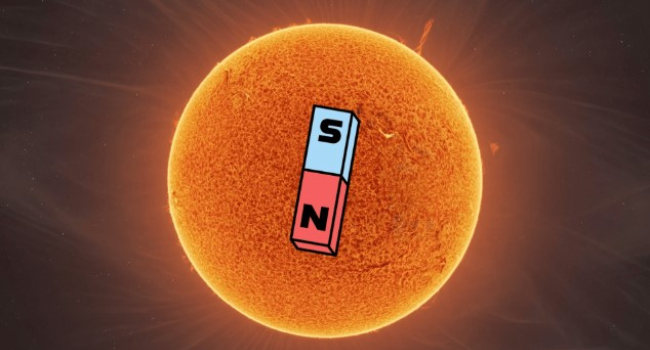
The Sun's magnetic field is about to flip: What does it mean and what to expect?
The Sun is on the verge of an important event: a change in its magnetic field. This phenomenon occurs about every 11 years and is an important phase of the solar cycle. The polarity reversal occurs when the sun is halfway through peak activity and when the transition to solar minimum begins. The last change in the magnetic field occurred in late 2013. What causes this change and is it dangerous?
The solar cycle
To understand the change in the magnetic field, it is necessary to understand the solar cycle. This approximately 11-year cycle of solar activity is driven by the sun's magnetic field and is reflected in the frequency and intensity of visible sunspots on the sun's surface. The peak of solar activity during the solar cycle is known as the solar maximum, which is currently estimated to occur between late 2024 and early 2026.
Another important, though lesser known, cycle involves two 11-year solar cycles. It's known as the Hale cycle and lasts about 22 years, during which the sun's magnetic field changes and then returns to its original state, astrophysicist and author Ryan French told Space.com.
During solar minimum, the Sun's magnetic field resembles a dipole with distinct north and south poles similar to Earth's magnetic field. And as we approach solar maximum, "the sun's magnetic field becomes more complex, without a clear north-south pole division," French explains. As solar maximum passes and solar minimum arrives, the sun returns to dipole form, albeit with reversed polarity.
As a result of the upcoming change in the magnetic field, the north and south magnetic fields in their respective hemispheres will change. According to French, this would lead to a magnetic orientation similar to Earth's.
Causes of changing magnetic field
The variation in the magnetic field is caused by sunspots, magnetically complex regions on the Sun's surface that can cause solar events such as solar flares and coronal mass ejections. When sunspots appear near the equator, they align with the old magnetic field, while those near the poles align with the new magnetic orientation, following Hale's Law.
"From the active regions, the magnetic field moves toward the poles and ultimately causes the poles to shift," says physicist Todd Hoekseman, director of Stanford University's Wilcox Solar Observatory. However, according to scientists, the exact cause of this phenomenon remains a mystery. "We still don't have a full mathematical description of what's going on," said Stanford University physicist Phil Scherer.
How fast is the change happening?
The change in the solar magnetic field is a gradual process, going from a dipole to a complex magnetic field and back to a reverse dipole over the course of 11 years. "There is no specific 'moment' when the sun's poles reverse," French explained. A complete change usually takes a year or two, although this can vary considerably. For example, in the case of the north polar field of Solar Cycle 24, which ended in December 2019, that change took about five years.
Impact on Earth
A change in the Sun's magnetic field is not a sign of impending doom. "Tomorrow will not be the end of the world," Scherer assured. However, some side effects will be felt on Earth. During this change, increased solar activity can cause strong geomagnetic storms on Earth, which in turn will cause the aurora borealis.
- Related News
- NASA releases video simulation of flight to Pillars of Creation
- Samples taken from Moon՛s far side for first time have been removed from capsule and sent for study
- NASA assigned SpaceX the task of landing ISS from space and will pay $843 million for it
- Powerful flare occurs in active part of Sun: What effect did it have on earth?
- China makes a historic breakthrough: Chang'e-6 probe delivers soil samples from the far side of the Moon
- NASA admits it cannot protect the Earth from asteroid collision
- Most read
month
week
day
- NASA admits it cannot protect the Earth from asteroid collision 1494
- Jelly Max: World's smallest 5G phone 857
- China makes a historic breakthrough: Chang'e-6 probe delivers soil samples from the far side of the Moon 779
- Debris of Chinese rocket fell near the settlement (video) 706
- How and why is artificial intelligence worsening climate on Earth? 695
- Apple to replace half of iPhone assembly line workers with robots 694
- Why won't older iPhones and Vision Pro get AB support? Apple's clarification 638
- WhatsApp for iOS gets new feature 635
- 6100mAh, 100W, IP65, 24GB RAM and Snapdragon 8 Gen 3։ OnePlus Ace 3 Pro’s specs are known 626
- Samsung unveils which smartphones will receive Android 15 611
- Archive
